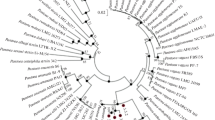Abstract
As understanding of the evolutionary relationships between strains and species of root nodule bacteria increases the need for a rapid identification method that correlates well with phylogenetic relationships is clear. We have examined 123 strains ofRhizobium: R. fredii (19),R. galegae (20),R. leguminosarum (22),R. loti (17),R. meliloti (21), andR. tropici (18) and six unknowns. All strains were grown on modified tryptone yeast-extract (TY) agar, as log phase cultures, scraped from the agar, lysed, and the released fatty acids derivatized to their corresponding methyl esters. The methyl esters were analysed by gas-chromatography using the MIDI/Hewlett-Packard Microbial Identification System. All species studied contained 16:0, 17:0, 18:0 and 19cyclow9C fatty acids but onlyR loti andR tropici produced 12:0 3 OH,13:0 iso 3 OH,18:1w9C and 15:0 iso 3 OH,17:0 iso 3 OH and 20:2w6,9C fatty acids respectively. Principal component analysis was used to show that strains could be divided into clusters corresponding to the six species. Fatty acid profiles for each species were developed and these correctly identified at least 95% of the strains belonging to each species. A dendrogram is presented showing the relationships betweenRhizobium species based on fatty acid composition. The data base was used to identify unknown soil isolates as strains ofRhizobium lacking a symbiotic plasmid and a bacterium capable of expressing a symbiotic plasmid fromR. leguminosarum asSphingobacterium spiritovorum.
Similar content being viewed by others
Abbreviations
- 16SrRNA:
-
16S ribosomal ribonucleic acid
- MIS:
-
Microbial identification system
- FAME:
-
Fatty acid methyl ester
- FID:
-
Flame ionization detector
- TY:
-
Tryptone yeast extract
- ECL:
-
Equivalent carbon length
- ED:
-
Euclidean distance and
- UPGMA:
-
Unweighted pair group method with arithmetric averages
References
Beringer J E 1974 R-factor transfer inRhizobium leguminosarum. J. Gen. Microbiol. 84, 188–198.
Chen W X, Li G S, Qi Y L, Wang E T, Yuan H L and Li J L 1991Rhizobium huakuii sp. nov. isolated from the root nodules ofAstragalus sinicus. Int. J. Syst Bacteriol 41, 275–280.
Dangeard P A 1926 Recherches sur les tubercles radicaux dex legumineuses Botaniste (Paris) 16, 1–275.
Frank B 1879 Ueber die parasiten in den wurzelanschwillungen der Papilionaceen. Ber. Deut. Bot. Ges. 37, 376–387, 394–399.
Graham P H, Sadowsky M J, Keyser H H, Barnet Y M, Bradley R S, Cooper J E, DeLey J, Jarvis B D W, Roslycky E B, Strijdon B W and Young J P W 1991 Proposed minimal standards for the description of new genera and species of root-and stem-nodulating bacteria. Int. J. Syst.Bacteriol. 41, 582–587.
Jarvis B D W, Downer H L and Young J P W 1992 Phylogeny of fast-growing soybean-nodulating rhizobia supports synonymy ofSinorhizobium andRhizobium and assignment toRhizobium fredii. Int. J. Syst. Bacteriol. 42, 93–96.
Jarvis B D W, Gillis M and DeLey J 1986 Intra- and intergeneric similarities between the ribosomal ribonucleic acid cistrons ofRhizobium andBradyrhizobium species and some related bacteria. Int. J. Syst. Bacteriol 36, 129–138.
Jarvis B D W, Pankhurst C E and Patel J J 1982Rhizobium loti a new species of legume root nodule bacteria. Int. J. Syst. Bacteriol 32, 378–380.
Lindström K 1989Rhizobium galegae a new species of legume root nodule bacteria. Int., J. Syst. Bacteriol. 39, 365–367.
Martínez-Romero E, Segovia L, Martius-Mercante F, Franco A A, Graham P and Pardo M A 1991Rhizobium tropici a novel species nodulatingPhaselus vulgaris L. beans andLeuceana sp trees. Int. J. Syst. Bacteriol. 41, 417–426.
Sawada H, Takikawa Y and Ieki H 1992 Fatty acid methyl ester profiles of genusAgrobacterium. Ann. Phytopath. Soc. Japan. 58, 46–51.
Scholla M H and Elkan G H 1984Rhizobium fredii sp. nov., a fast-growing species that effectively nodulates soybeans. Int. J. Syst. Bacteriol. 34, 484–486.
Segovia L, Young J P W and Martinez-Romero E 1993 Reclassification of AmericanRhizobium leguminosarum biovar phaseoli type I strains asRhizobium etli sp. nov. Int. J. Syst. Bacteriol. 43, 374–377.
Wedlock D N and Jarvis B D W 1986 DNA homologies betweenRhizobium fredii, rhizobia that nodulateGalega sp. and otherRhizobium andBradyrhizobium species. Int. J. Syst. Bacteriol. 36, 550–558.
Willems A and Collins M D 1993 Phylogenetic analysis of rhizobia and agrobacteria based on 16SrRNA gene sequences. Int. J. Syst. Bacteriol. 43, 305–313.
Author information
Authors and Affiliations
Rights and permissions
About this article
Cite this article
Jarvis, B.D.W., Tighe, S.W. Rapid identification ofRhizobium species based on cellular fatty acid analysis. Plant Soil 161, 31–41 (1994). https://doi.org/10.1007/BF02183083
Issue Date:
DOI: https://doi.org/10.1007/BF02183083




